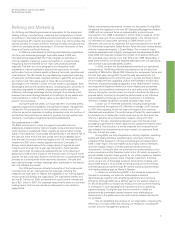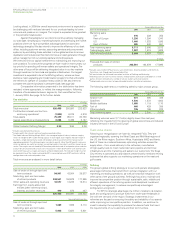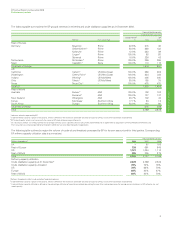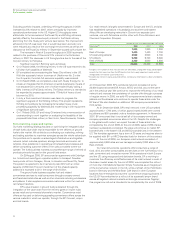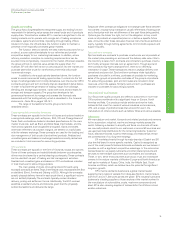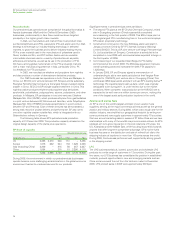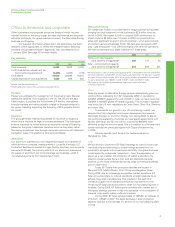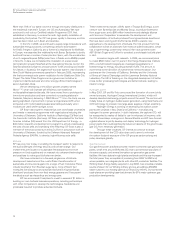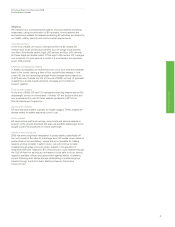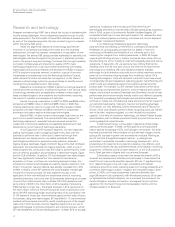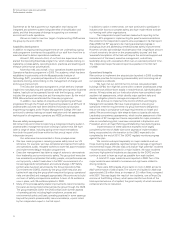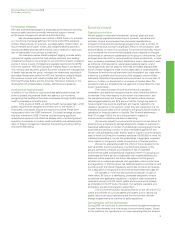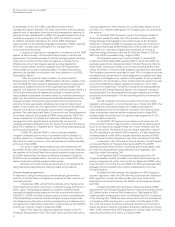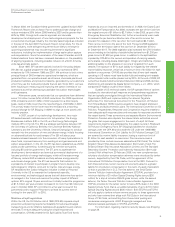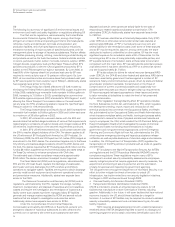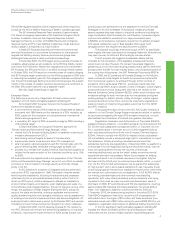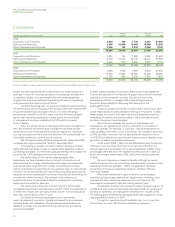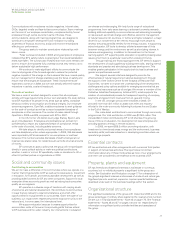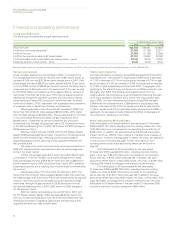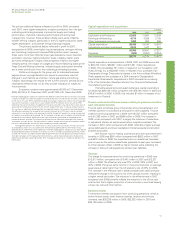BP 2008 Annual Report Download - page 42
Download and view the complete annual report
Please find page 42 of the 2008 BP annual report below. You can navigate through the pages in the report by either clicking on the pages listed below, or by using the keyword search tool below to find specific information within the annual report.
BP Annual Report and Accounts 2008
Performance review
Regulation of the group’s business
BP’s activities, including its oil and gas exploration and production,
pipelines and transportation, refining and marketing, petrochemicals
production, trading, alternative energy and shipping activities, are
conducted in many different countries and are therefore subject to a
broad range of EU, US, international, regional and local legislation and
regulations, including legislation that implements international
conventions and protocols. These cover virtually all aspects of our
activities and include matters such as licence acquisition, production
rates, royalties, environmental, health and safety protection, fuel
specifications and transportation, trading, pricing, anti-trust, export, taxes
and foreign exchange.
The terms and conditions of the leases, licences and contracts
under which our oil and gas interests are held vary from country to
country. These leases, licences and contracts are generally granted
by or entered into with a government entity or state company and are
sometimes entered into with private property owners. These
arrangements with governmental or state entities usually take the form
of licences or production-sharing agreements. Arrangements with private
property owners are usually in the form of leases.
Licences (or concessions) give the holder the right to explore for
and exploit a commercial discovery. Under a licence, the holder bears the
risk of exploration, development and production activities and provides
the financing for these operations. In principle, the licence holder is
entitled to all production, minus any royalties that are payable in kind. A
licence holder is generally required to pay production taxes or royalties,
which may be in cash or in kind. Less typically, BP may explore for and
exploit hydrocarbons under a service agreement with the host entity in
exchange for reimbursement of costs and/or a fee paid in cash rather
than production.
PSAs entered into with a government entity or state company
generally require BP to provide all the financing and bear the risk of
exploration and production activities in exchange for
a share of the production remaining after royalties, if any.
In certain countries, separate licences are required for exploration
and production activities and, in certain cases, production licences are
limited to a portion of the area covered by the exploration licence. Both
exploration and production licences are generally for a specified period of
time (except for licences in the US, which typically remain in effect until
production ceases). The term of BP’s licences and the extent to which
these licences may be renewed vary by area.
Frequently, BP conducts its exploration and production activities in
joint venture with other international oil companies, state companies or
private companies.
In general, BP is required to pay income tax on income generated
from production activities (whether under a licence or production-sharing
agreement). In addition, depending on the area, BP’s production activities
may be subject to a range of other taxes, levies and assessments,
including special petroleum taxes and revenue taxes. The taxes imposed
on oil and gas production profits and activities may be substantially higher
than those imposed on other activities, particularly in Angola, Norway,
the UK, Russia, South America and Trinidad & Tobago.
For a discussion of environmental and certain health and safety
regulations and environmental proceedings, see Environment on
page 43. See also Legal proceedings on page 92.
Safety
This section reviews BP’s safety performance in 2008.
There were five workforce fatalities in 2008, compared with seven
in 2007. One resulted from fatal injuries sustained during operations at
our Texas City refinery; one was the result of a fall from height at the
Tangguh operations in Indonesia; one fatality was on a land farm near
Texas City, and two were driving fatalities incidents in Mozambique and
South Africa. We deeply regret this loss of life. By learning from these
incidents and implementing appropriate improvement actions, we
continue to seek to secure the safety of all members of our workforce.
Our workforce reported recordable injury frequency, which measures the
number of injuries per 200,000 hours worked, was 0.43 in 2008. This was
a good improvement on the rate of 0.48 recorded in both 2007 and 2006.
Throughout 2008, senior leadership across the group continued to
hold safety as their highest priority. Site visits, in which safety was a
focus, were undertaken by the group chief executive (GCE) and members
of the executive team to reinforce the importance of their commitment
to safe and reliable operations.
Management systems
We continue to implement our new operating management system
(OMS), a framework for operations across BP that is integral to improving
safety and operating performance in every site.
When fully implemented, OMS will be the single framework
within which we will operate, consolidating BP’s requirements relating
to process safety, environmental performance, legal compliance in
operations, and personal, marine and driving safety. It embraces
recommendations made by the BP US Refineries Independent Safety
Review Panel (the panel), which reported in January 2007 on safety
management at our US refineries and our safety management culture.
The OMS establishes a set of requirements, and provides sites
with a systematic way to improve operating performance on a
continuous basis. BP businesses implementing OMS must work to
integrate group requirements within their local system to meet legal
obligations, address local stakeholder needs, reduce risk and improve
efficiency and reliability. A number of mandatory operating and
engineering technical requirements have been defined within the OMS,
to address process safety and related risks.
All operated businesses plan to transition to OMS by the end of
2010. Eight sites completed the transition to OMS in 2008; two
petrochemicals plants, Cooper River and Decatur, two refineries, Lingen
and Gelsenkirchen and four Exploration and Production sites, North
America Gas, the Gulf of Mexico, Colombia and the Endicott field in
Alaska. Implementation is continuing across the group and a number of
other sites, including all refineries not already operating the OMS, are
expected to complete the transition in 2009.
For the sites already involved, implementing OMS has involved
detailed planning, including gap assessments supported by external
facilitators. A core aspect of OMS implementation is that each site
produces its own ‘local OMS’, which takes account of relevant risks at
the site and details the site’s approach to managing those risks. As part
of its transition to OMS, a site issues its local OMS handbook, and this
summarizes its approach to risk management. Each site also develops a
plan to close gaps that is reviewed annually. The transition to OMS, at
local and group level, has been handled in a formal and systematic way,
to ensure the change is managed safely and comprehensively.
Performance review
41


